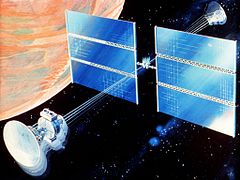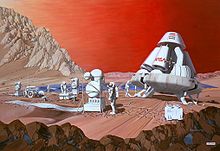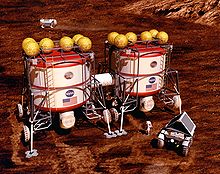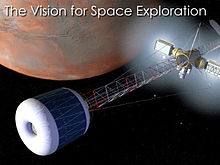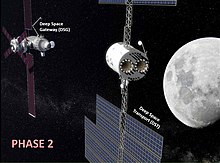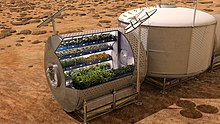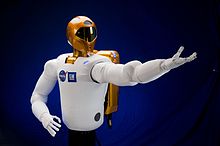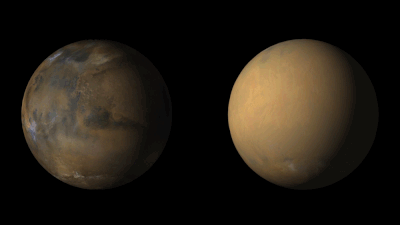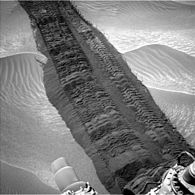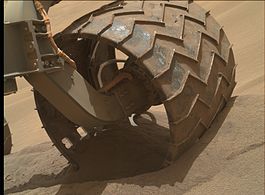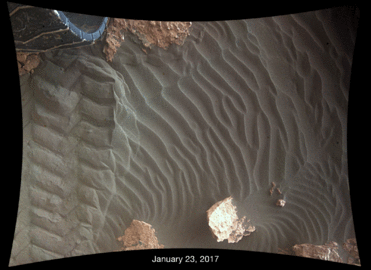Concept for Mars base with ice dome, pressurized rover, and Marsuits
Rendition of person in a spacesuit on Mars
Spacecraft for transporting crew to Mars
SpaceX Falcon Heavy, with more launch capacity than the Space Shuttle, was used to send a test payload beyond the orbit of Mars in early 2018.
A human mission to Mars has been the subject of science fiction, aerospace engineering, and scientific proposals since the 19th century. The plans comprise proposals to land on Mars, eventually settling on and terraforming the planet, while utilizing its moons, Phobos and Deimos.
The exploration of Mars has been a goal of national space programs for decades. Preliminary work for missions that would involve human explorers has been undertaken since the 1950s, with planned missions typically being stated as taking place 10 to 30 years in the future when they are drafted. The list of manned Mars mission plans in the 20th century shows the various mission proposals that have been put forth by multiple organizations and space agencies in this field of space exploration. Plans have varied from scientific expeditions in which a small (2 to 8) group visits Mars for a period of a few weeks or year, to the permanent colonization of Mars.
In the 2010s, numerous American, European, and Chinese agencies were developing proposals for human missions to Mars. They are now developing and testing the technologies.
Mars in fiction is a frequent target of exploration and settlement in books, graphic novels, and films.
Travel to Mars
Three views of planet Mars, the "red planet"
Closest approaches of Mars to Earth, 2014–2061. Communication times are slightly shorter when it is closest.
The energy needed for transfer between planetary orbits, or "∆V", is lowest at intervals fixed by the synodic period. For Earth / Mars trips, this is every 26 months (2 years and 2 months), so missions are typically planned to coincide with one of these launch windows. Due to the eccentricity of Mars' orbit, the energy needed in the low-energy windows varies on roughly a 15-year cycle with the easiest windows needing only half the energy of the peaks. In the 20th century, there was a minimum in the 1969 and 1971 launch windows and another low in 1986 and 1988, then the cycle repeated. The next low-energy launch window occurs in 2033.
Several types of mission plans have been proposed, such as the opposition class and conjunction class, or the Crocco flyby. The lowest energy transfer to Mars is a Hohmann transfer orbit; a mission to Mars using Hohmann transfer involves an approximately 9 month travel time from Earth to Mars, about five hundred days at Mars to wait for the transfer window to Earth, and a Hohmann transfer of about 9 months to return to Earth.
Shorter Mars mission plans have round-trip flight times of 400 to 450 days, but requiring a higher energy. A fast Mars mission of 245 days round trip could be possible with on-orbit staging. In 2014 ballistic capture was proposed, which may reduce fuel cost and provide more flexible launch windows compared to the Hohmann.
In the Crocco grand tour, a crewed spacecraft would get a flyby of Mars and Venus for under a year in space. Some flyby mission architectures can also be extended to include a style of Mars landing with a flyby excursion lander spacecraft. Proposed by R. Titus in 1966, it involved extending a flyby mission with a short stay lander. Basically, a short stay lander-ascent vehicle would separate from a "parent" Earth-Mars transfer prior to its flyby of Mars. The Ascent-Descent lander would arrive sooner and either go into orbit around Mars or land, and depending on the design offer perhaps 10–30 days before it needed to launch itself back to the main transfer vehicle.
Aerobraking at Mars was estimated in the 1980s to cut the mass of a Mars mission lifted off the Earth by half. As a result, Mars missions have designed interplanetary spacecraft and landers capable of aero-braking.
Landing on Mars
Insets depict observation and analysis to find a safe landing site
When an expedition reaches the orbit of Mars, it may drop into orbit around Mars by either of two main options: using rockets to slow down, or aerocapture. The same is true for missions to the surface. The state of the atmosphere, the altitude, and the properties of the landing site must come into consideration for a surface landing. It may be necessary to avoid a scientifically interesting site in the interest of safe touchdown.
Aerocapture at Mars for human missions was studied in the 20th century. In a review of 93 Mars studies 24 used aerocapture for Mars or Earth return. One of the considerations for using aerocapture on crewed missions is a maximum G-limit to experience, for which it was noted 5-g's (5 times Earth gravity) was a common limit to be planned for.
There may be several landers, for example, separate ones for the crew, a habitat, rover, supplies, ascent vehicle, etc.
Landed spacecraft on the surface of Mars:
- Viking 1 & 2
- Mars Pathfinder (includes Sojourner)
- MER A & B (Spirit & Opportunity)
- Phoenix
- Curiosity
Challenges
One of the big challenges to landing on Mars was overcome by Mariner 4, when it showed the properties of the atmosphere. Another was a basic survey of the planet, to know what place might be suitable to land. This has been overcome in stages, with major global surveys done by Mariner 9 and Viking 1 and 2 orbiters, which supported the Viking landers finding a suitable landing site. Later orbiters such as Mars Global Surveyor, 2001 Mars Odyssey, Mars Express, and Mars Reconnaissance Orbiter, have helped identify the location of water, a critical resource.Logistical
The estimated cost of sending humans to Mars is roughly 500 billion U.S. dollars, though the actual costs are likely to be more. The largest limiting factor for sending humans to Mars is funding. In the late 1950s, rivalry between the Soviet Union and the United States stimulated a national priority to send humans to the Moon. Under the current global geopolitical climate, however, government funding of these programs has decreased. Recent participation of private companies in space travel and participation by new nations such as India may present new opportunities.Critics argue the immediate benefits of establishing a human presence on Mars are more esoteric than practical. Yet proponents of human space exploration contend that while the short term benefits will be academic, the symbolism of establishing a presence in space may garner public interest to join the cause and spark global cooperation. Furthermore, experts maintain that a long-term investment will be necessary for humanity’s survival.
Medical
Comparison of radiation doses – includes the amount detected on the trip from Earth to Mars by the RAD inside the MSL (2011–2013). Vertical axis is in logarithmic scale,
so the dose over a Mars year is about 15 times the DOE limit, not less
than twice, as a quick glance might suggest. The actual dose would
depend on factors such as spacecraft design and natural events such as solar flares.
There are several key physical challenges for human missions to Mars:
- Health threat from cosmic rays and other ionizing radiation. In May 2013, NASA scientists reported that a possible mission to Mars may involve great radiation risk based on energetic particle radiation measured by the RAD on the Mars Science Laboratory while traveling from the Earth to Mars in 2011–2012. The calculated radiation dose was 0.66 sieverts round-trip. The agency's career radiation limit for astronauts is 1 sievert. In September 2017, NASA reported radiation levels on the surface of the planet Mars were temporarily doubled, and were associated with an aurora 25-times brighter than any observed earlier, due to a massive, and unexpected, solar storm in the middle of the month.
Artistic vision of spacecraft providing artificial gravity by spinning.
- Negative effects of a prolonged weightlessness environment on human health, including eyesight visual impairment. (Depends on mission and spacecraft design).
- Psychological effects of isolation from Earth and, by extension, the lack of community due to impossibility of real-time connections with Earth.
- Social effects of several humans living under cramped conditions for more than one Earth year, possibly two or three years, on the mission to Mars, and a comparable length of time on the return to Earth. (Depends on spacecraft and mission design).
- Inaccessibility of terrestrial medical facilities.
- Potential failure of propulsion or life-support equipment.
Planetary protection
Robotic spacecraft to Mars are required to be sterilized, to have at most 300,000 spores on the exterior of the craft—and more thoroughly sterilized if they contact "special regions" containing water, as otherwise there is a risk of contaminating not only the life-detection experiments but possibly the planet itself.It is impossible to sterilize human missions to this level, as humans are host to typically a hundred trillion microorganisms of thousands of species of the human microbiota, and these cannot be removed while preserving the life of the human. Containment seems the only option, but it is a major challenge in the event of a hard landing (i.e. crash). There have been several planetary workshops on this issue, but with no final guidelines for a way forward yet. Human explorers would also be vulnerable to back contamination to Earth if they become carriers of microorganisms.
Mission proposals
20th century
Fuel is mined from Phobos with the help of a nuclear reactor.
Wernher von Braun proposal (1947 through 1950s)
Wernher von Braun was the first person to make a detailed technical study of a Mars mission. Details were published in his book Das Marsprojekt (1952, published in English as The Mars Project in 1962) and several subsequent works. Willy Ley popularized a similar mission in English in the book The Conquest of Space (1949), featuring illustrations by Chesley Bonestell. Von Braun's Mars project envisioned nearly a thousand three-stage vehicles launching from Earth to ferry parts for the Mars mission to be constructed at a space station in Earth orbit. The mission itself featured a fleet of ten spacecraft with a combined crew of 70 heading to Mars, bringing three winged surface excursion ships that would land horizontally on the surface of Mars. (Winged landing was considered possible because at the time of his proposal, the Martian atmosphere was believed to be much denser than was later found to be the case.)In the 1956 revised vision of the Mars Project plan, published in the book The Exploration of Mars by Wernher Von Braun and Willy Ley, the size of the mission was trimmed, requiring only 400 launches to put together two ships, still carrying a winged landing vehicle. Later versions of the mission proposal, featured in the Disney "Man In Space" film series, showed nuclear-powered ion-propulsion vehicles for the interplanetary cruise.
U.S. proposals (1950s, 1960s, and 1970s)
Artist's conception of the Mars Excursion Module (MEM) proposed in a NASA study in 1963. Crew wear Mars suits on surface EVA from the module.
In 1962, Aeronutronic Ford, General Dynamics and the Lockheed Missiles and Space Company made studies of Mars mission designs as part of NASA Marshall Spaceflight Center "Project EMPIRE". These studies indicated that a Mars mission (possibly including a Venus fly-by) could be done with a launch of eight Saturn V boosters and assembly in low Earth orbit, or possibly with a single launch of a hypothetical "post Saturn" heavy-lift vehicle. Although the EMPIRE missions were only studies, and never proposed as funded projects, these were the first detailed analyses of what it would take to accomplish a human voyage to Mars using data from actual NASA spaceflight, and laid much of the basis for future studies, including significant mission studies by TRW, North American, Philco, Lockheed, Douglas, and General Dynamics, along with several in-house NASA studies.
Following the success of the Apollo Program, von Braun advocated a manned mission to Mars as a focus for NASA's manned space program. Von Braun's proposal used Saturn V boosters to launch nuclear-powered (NERVA) upper stages that would power two six-crew spacecraft on a dual mission in the early 1980s. The proposal was considered by President Richard Nixon but passed over in favor of the Space Shuttle.
In 1975, von Braun discussed the mission architecture that emerged from these Apollo-era studies in a recorded lecture and while doing so suggested that multiple Shuttle launches could instead be configured to lift the two Nuclear Thermal Rocket engine equipped spacecraft in smaller parts, for assembly in-orbit.
Soviet mission proposals (1956 through 1969)
The Martian Piloted Complex or "'MPK'" was a proposal by Mikhail Tikhonravov of the Soviet Union for a manned Mars expedition, using the (then proposed) N1 rocket, in studies from 1956 to 1962. The Soviets sent many probes to Mars with some noted success stories including Mars atmospheric entry, but the ratio was low and their space program struggled through disasters like the lost Salyut 1 crew and explosions of their N1 rocket.Heavy Interplanetary Spacecraft (known by the Russian acronym TMK) was the designation of a Soviet Union space exploration proposal in the 1960s to send a manned flight to Mars and Venus (TMK-MAVR design) without landing. The TMK spacecraft was due to launch in 1971 and make a three-year-long flight including a Mars fly-by at which time probes would have been dropped. The project was never completed because the required N1 rocket never flew successfully. The Mars Expeditionary Complex, or "'MEK"' (1969) was another Soviet proposal for a Mars expedition that would take a crew from three to six to Mars and back with a total mission duration of 630 days.
Case for Mars (1981–1996)
Following the Viking missions to Mars, between 1981 and 1996 a series of conferences named The Case for Mars were held at the University of Colorado at Boulder. These conferences advocated human exploration of Mars, presented concepts and technologies, and held a series of workshops to develop a baseline concept for the mission. It proposed use of in-situ resource utilization to manufacture rocket propellant for the return trip. The mission study was published in a series of proceedings volumes. Later conferences presented alternative concepts, including the "Mars Direct" concept of Robert Zubrin and David Baker; the "Footsteps to Mars" proposal of Geoffrey A. Landis, which proposed intermediate steps before the landing on Mars, including human missions to Phobos; and the "Great Exploration" proposal from Lawrence Livermore National Laboratory, among others.NASA Space Exploration Initiative (1989)
Artist's conception of a human mission on the surface of Mars
1989 painting by Les Bossinas of Lewis Research Center for NASA
1989 painting by Les Bossinas of Lewis Research Center for NASA
In response to a presidential initiative, NASA made a study of a project for human lunar- and Mars exploration as a proposed follow-on to the International Space Station project. This resulted in a report, called the 90-day study, in which the agency proposed a long-term plan consisting of completing the Space Station as "a critical next step in all our space endeavors," returning to the Moon and establishing a permanent base, and then sending astronauts to Mars. This report was widely criticized as too elaborate and expensive, and all funding for human exploration beyond Earth orbit was canceled by Congress.
Mars Direct (early 1990s)
Because of the greater distance, the Mars mission would be much more risky and expensive than past Moon flights. Supplies and fuel would have to be prepared for a 2-3 year round trip and the spacecraft would need at least partial shielding from ionizing radiation. A 1990 paper by Robert Zubrin and David A. Baker, then of Martin Marietta, proposed reducing the mission mass (and hence the cost) by using in situ resource utilization to manufacture propellant from the Martian Atmosphere. This proposal drew on concepts developed by the former "Case for Mars" conference series. Over the next decade, Zubrin developed it into a mission concept, Mars Direct, which he presented in a book, The Case for Mars (1996). The mission is advocated by the Mars Society, which Zubrin founded in 1998, as practical and affordable.International Space University (1991)
In 1991 in Toulouse, France, the International Space University studied an international human Mars mission. They proposed a crew of 8 traveling to Mars in a nuclear-powered vessel with artificial gravity provided by rotation. On the surface, 40 tonne habitats pressurized to 10 psi (69 kPa) were powered by a 40 kW photovoltaic array.NASA Design reference missions (1990s)
NASA Mars habitat concept for DRA 1.0, derived from the Mars Direct Architecture. (1995)
In the 1990s NASA developed several conceptual level human Mars exploration architectures. One of these was NASA Design reference mission 3.0 (DRM 3.0) to stimulate further thought and concept development.
Selected other US/NASA studies (1988–2009):
- 1988 "Mars Expedition"
- 1989 "Mars Evolution"
- 1990 "90-Day Study"
- 1991 "Synthesis Group"
- 1995 "DRM 1"
- 1997 "DRM 3"
- 1998 "DRM 4"
- 1999 "Dual Landers"
21st century
Crew members setting up weather monitoring equipment on the surface of Mars (artist's concept)
NASA Design reference missions (2000+)
The NASA Mars Design Reference Missions consisted of a series of conceptual design studies for human Mars missions, continued in the 21st century Selected other US/NASA plans (1988–2009):- 2000 SERT (SSP)
- 2001 DPT/NEXT
- 2002 NEP Art. Gravity
- 2009 DRA 5
MARPOST (2000–2005)
The Mars Piloted Orbital Station (or MARPOST) is a Russian proposed manned orbital mission to Mars, using a nuclear reactor to run an electric rocket engine. Proposed in October 2000 by Yuri Karash from the Russian Academy of Cosmonautics as the next step for Russia in space along with the Russian participation in the International Space Station, a 30-volume draft project for MARPOST was confirmed as of 2005. Design for the ship was proposed to be ready in 2012, and the ship itself in 2021.ESA Aurora programme (2001+)
Artwork featuring astronauts enduring a Mars dust storm near a rover
The European Space Agency had a long-term vision of sending a human mission to Mars in 2033. Laid out in 2001, the project's proposed timeline would begin with robotic exploration, a proof of concept simulation of sustaining humans on Mars, and eventually a manned mission; however, objections from the participating nations of ESA and other delays have put the timeline into question. Nevertheless, a spawn of this programme, ExoMars, delivered an orbiter to Mars in 2016
ESA/Russia plan (2002)
Another proposal for a joint ESA mission with Russia is based on two spacecraft being sent to Mars, one carrying a six-person crew and the other the expedition's supplies. The mission would take about 440 days to complete with three astronauts visiting the surface of the planet for a period of two months. The entire project would cost $20 billion and Russia would contribute 30% of these funds.USA Vision for Space Exploration (2004)
Project Constellation included an Orion Mars Mission. (Then United States President) George W. Bush announced an initiative of manned space exploration on January 14, 2004, known as the Vision for Space Exploration. It included developing preliminary plans for a lunar outpost by 2012 and establishing an outpost by 2020. Precursor missions that would help develop the needed technology during the 2010–2020 decade were tentatively outlined by Adringa and others. On September 24, 2007, Michael Griffin, then NASA Administrator, hinted that NASA may be able to launch a human mission to Mars by 2037. The needed funds were to be generated by diverting $11 billion from space science missions to the vision for human exploration.
NASA has also discussed plans to launch Mars missions from the Moon to reduce traveling costs.
Mars Society Germany – European Mars Mission (EMM) (2005)
The Mars Society Germany proposed a manned Mars mission using several launches of an improved heavy-lift version of the Ariane 5. Roughly 5 launches would be required to send a crew of 5 on a 1200 days mission, with a payload of 120,000 kg (260,000 lb). Total project was estimated to cost 10 to 15 billion Euros.China National Space Administration (CNSA) (2006)
Sun Laiyan, administrator of the China National Space Administration, said on July 20, 2006 that China would start deep space exploration focusing on Mars over the next five years, during the Eleventh Five-Year Plan (2006–2010) Program period. The first uncrewed Mars exploration program could take place between 2014–2033, followed by a crewed phase in 2040–2060 in which crew members would land on Mars and return home. The Mars 500 study of 2011 prepared for this manned mission.The One-Way Trip Option (2006); Mars to Stay (2006)
The idea of a one-way trip to Mars has been proposed several times. Space activist Bruce Mackenzie, for example, proposed a one-way trip to Mars in a presentation "One Way to Mars – a Permanent Settlement on the First Mission" at the 1998 International Space Development Conference, arguing that since the mission could be done with less difficulty and expense without a return to Earth, the first mission to Mars should be a settlement, not a visit. In 2006, former NASA engineer James C. McLane III proposed a scheme to initially colonize Mars via a one-way trip by only one human. Papers discussing this concept appeared in The Space Review, Harper's Magazine, SEARCH Magazine and The New York Times.Former Apollo astronaut Buzz Aldrin is a particularly outspoken promoter who has suggested in numerous forums "Forget the Moon, Let's Head to Mars!" In June 2013, Aldrin wrote an opinion, published in The New York Times, supporting a manned mission to Mars and which viewed the Moon "not as a destination but more a point of departure . . . " In August 2015, Aldrin, in association with the Florida Institute of Technology, presented a "master plan" for NASA consideration proposing astronauts with a "tour of duty of ten years" colonize Mars before the year 2040.
NASA Design Reference Mission 5.0 (2007)
NASA released initial details of the latest version conceptual level human Mars exploration architecture in this presentation. The study further developed concepts developed in previous NASA DRM and updated it to more current launchers and technology.NASA Design Reference Mission Architecture 5.0 (2009)
Concept for NASA's Design Reference Mission Architecture 5.0 (2009)
NASA released an updated version of NASA DRM 5.0 in early 2009, featuring use of the Ares V launcher, Orion CEV, and updated mission planning.
NASA Austere Human Missions to Mars (2009)
Extrapolated from the DRMA 5.0, plans for a manned Mars expedition with chemical propulsion. Austere Human Missions to MarsUSA's Mars orbit by the mid-2030s (2010)
In a major space policy speech at Kennedy Space Center on April 15, 2010, then-U.S. President Barack Obama predicted a manned Mars mission to orbit the planet by the mid-2030s, followed by a landing:By the mid-2030s, I believe we can send humans to orbit Mars and return them safely to Earth. And a landing on Mars will follow. And I expect to be around to see it.The United States Congress has mostly approved a new direction for NASA that includes canceling Bush's planned return to the Moon by 2020 and instead proposes asteroid exploration in 2025 and orbiting Mars in the 2030s. The Asteroid Redirect Mission was cancelled in June 2017 and "closed out" in September of the same year.
Martian Frontier (2007–2011)
Mars 500, the longest high fidelity spaceflight simulation, ran from 2007 to 2011 in Russia and was an experiment to assess the feasibility of manned missions to Mars.Russian mission proposals (2011)
A number of Mars mission concepts and proposals have been put forth by Russian scientists. Stated dates were for a launch sometime between 2016 and 2020. The Mars probe would carry a crew of four to five cosmonauts, who would spend close to two years in space.In late 2011, Russian and European space agencies successfully completed the ground-based MARS-500. The biomedical experiment simulating manned flight to Mars was completed in Russia in July 2000.
2-4-2 concept (2011–2012)
In 2011, Jean-Marc Salotti published a new proposal for a manned Mars mission, with a release in 2012. The 2-4-2 concept is based on a reduction of the crew size to only 2 astronauts and the duplication of the entire mission. There are 2 astronauts in each space vehicle, there are 4 on the surface of Mars and there are 2 once again in each return vehicle. In addition, at every step of the mission, there are 2 astronauts ready to help the 2 others (2 for 2). This architecture simplifies the entry, descent and landing procedures, which are known to be very risky, thanks to a significant reduction of the size of the landing vehicles. It also avoids the assembly of huge vehicles in LEO. The author claims that his proposal is much cheaper than the NASA reference mission without compromising the risks and can be undertaken before 2030.Conceptual Space Vehicle Architecture for Human Exploration of Mars (2012)
In 2012, Conceptual Space Vehicle Architecture for Human Exploration of Mars, with Artificial Gravity and Mini-Magnetosphere Crew Radiation Shield was released, laying out a possible design for a human Mars mission. Components of the architecture include various spacecraft for the Earth-to-Mars journey, landing, and surface stay as well as return. Some features include several unmanned cargo landers assembled into a base on the surface of Mars. The crew would land at this base in the "Mars Personnel Lander", which could also take them back into Mars orbit. The design for the manned interplanetary spacecraft included artificial-gravity and an artificial magnetic field. Overall, the architecture was modular and to allow for incremental R&D.Mars One (2012)
In 2012, a Dutch entrepreneur group began raising funds for a human Mars base to be established in 2023. The mission is intended to be primarily a settlement mission with no return trip to Earth planned. Astronaut applications were invited from the public all over the world.The initial plan included an orbiter and demonstration lander in 2018, followed by a rover in 2020, and the base components in 2024. Mars One suggested it could use a SpaceX Heavy rocket to launch flight hardware. The first crew of four astronauts were to land on Mars in 2025. Then, every two years, a new crew of four would arrive. The entire mission is to be filmed and broadcast as a media event. Revenues from broadcasting would help fund the program. In April 2015, Mars One’s CEO Bas Lansdorp admitted that their 12-year plan for landing humans on Mars by 2027 is mostly fiction.
Inspiration Mars Foundation (2013)
In 2013, the Inspiration Mars Foundation founded by Dennis Tito revealed plans of a manned mission to fly by Mars in 2018 with support from NASA. NASA refused to fund the mission.Boeing Affordable Mission (2014)
On December 2, 2014, NASA's Advanced Human Exploration Systems and Operations Mission Director Jason Crusan and Deputy Associate Administrator for Programs James Reuthner announced tentative support for the Boeing "Affordable Mars Mission Design" including radiation shielding, centrifugal artificial gravity, in-transit consumable resupply, and a lander which can return. Reuthner suggested that if adequate funding was forthcoming, the proposed mission would be expected in the early 2030s.NASA's Journey to Mars: Pioneering Next Steps in Space Exploration (2015)
Artist's rendering of a Block 1 SLS
On October 8, 2015, NASA published its strategy for human exploration and colonization of Mars. The concept operates through three distinct phases leading up to fully sustained colonization.
The first stage, already underway, is the "Earth Reliant" phase. This phase continues using the International Space Station until 2024; validating deep space technologies and studying the effects of long duration space missions on the human body.
The second stage, "Proving Ground," moves away from Earth reliance and ventures into cislunar space for most of its tasks. The proposed Lunar Orbital Platform-Gateway would test deep space habitation facilities, and validate capabilities required for human exploration of Mars.
Finally, phase three is the transition to independence from Earth resources. The "Earth Independent" phase includes long term missions on the lunar surface with surface habitats that only require routine maintenance, and the harvesting of Martian resources for fuel, water, and building materials. NASA is still aiming for human missions to Mars in the 2030s, though Earth independence could take decades longer.
In November 2015, Administrator Bolden of NASA reaffirmed the goal of sending humans to Mars. He laid out 2030 as the date of a manned surface landing, and noted that planned 2020 Mars rover would support the human mission. Also discussed was the use of robotics to prepare an underground habitat for the arriving people. He noted the advantages of living underground on Mars, especially that it eliminates the need to construct above ground shielding. The underground base would be prepared in advance by an armada of robots. Top surface activity was not excluded however, just that the crew would "probably live underground for the most part".
SpaceX Mars transportation infrastructure (2016-)
Since 2016, SpaceX publicly announced a comprehensive vision to begin the colonization of Mars, by proposing to develop a high-capacity transportation infrastructure.ITS launch vehicle
In September 2016 at the International Astronautical Congress, Elon Musk announced the ITS launch vehicle design (informally discussed earlier as the Mars Colonial Transporter), that comprised a large reusable booster topped by a spaceship or a tanker for in-orbit refueling, as well as a propellant plant to be built on Mars, at a base referred to as Mars Base Alpha. The aspirational objective is to advance the technology and infrastructure such that the first humans to Mars could potentially depart as early as 2024.BFR (Big Falcon Rocket)
On 29 September 2017, Elon Musk announced an updated vehicle design for the Mars mission at the International Astronautical Congress. The replacement vehicle for this mission is called BFR (Big Falcon Rocket). BFR will provide the on-orbit activity like satellite delivery, servicing the International Space Station, Moon mission, as well as Mars mission. There are two phases for the human mission to Mars via BFR:- In 2022, at least 2 BFR cargo vehicles will land on Mars.
- They will confirm water resources and identify hazards.
- They will place power, mining and life support infrastructure for future missions.
- In 2024, 2 BFR crew vehicles will take the first people to Mars.
- 2 BFR cargo vehicles will bring more equipment and supplies.
- They will place a propellant production plant.
- They will build up a base to prepare for expansion.
Mars Base Camp (2016)
Mars Base Camp (MBC), an American spacecraft concept that proposes to send astronauts to Mars orbit as early as 2028. The vehicle concept, developed by Lockheed Martin, would utilize both future and heritage technology as well as the Orion MPCV built by NASA.Deep Space Transport (2017)
Deep Space Transport
Current intentions by nations and space agencies
Artist's rendering of the planned Orion/DSH/Cryogenic Propulsion Module assembly.
A number of nations and organizations have long-term intentions to send humans to Mars.
- The United States has several robotic missions currently exploring Mars, with a sample-return planned for the future. The Orion Multi-Purpose Crew Vehicle (MPCV) is intended to serve as the launch/splashdown crew delivery vehicle, with a Deep Space Habitat module providing additional living-space for the 16-month-long journey. The first manned Mars Mission, which will include sending astronauts to Mars, orbiting Mars, and a return to Earth, is scheduled for the 2030s. Technology development for US government missions to Mars is underway, but there is no well-funded approach to bring the conceptual project to completion with human landings on Mars by the mid-2030s, the stated objective. NASA is under presidential orders to land humans on Mars by 2033, and NASA-funded engineers are studying a way to build potential human habitats there by producing bricks from pressurized Martian soil.
- The European Space Agency has a long-term goal to send humans but has not yet built a manned spacecraft. It has sent robotic probes like ExoMars in 2016 and plans to send the next probe in 2020.
A Soyuz landing on Earth in 2015
- India successfully placed an unmanned Mars Orbiter Mission (also called Mangalyaan) satellite in Mars orbit in 2014. ISRO plans a larger follow-up mission called Mangalyaan 2 between 2018 and 2020. This mission will likely consist of a lander and a Mars rover. No plans for an Indian human mission to Mars have been made public.
- Japan has sent one robotic mission to Mars in 1998, the Nozomi, but it failed to achieve Mars orbit. JAXA has proposed a rover mission called MELOS for an engineering demonstration of precision landing, and to look for possible biosignatures on Mars in 2020 or 2022. No plans for a Japanese human mission to Mars have been made public.
- China's first attempted mission to Mars, the Yinghuo-1 space probe, was lost with Russia's sample return mission to Phobos, Fobos-Grunt in 2011–2012. China plans to develop and launch an orbiter, lander and rover to Mars in July or August 2020 with a Long March 5 heavy lift rocket. A crewed phase is planned for the 2040–2060 timeframe.
- Russia plans to send humans in the 2040–2045 timeframe.
Current intentions by private companies
United States-based launch company SpaceX intends to establish a permanent Mars base in the 2020s, using the BFR fully reusable launch system. The current plan is for 2 unmanned BFRs to fly to Mars in 2022, establishing a rocket propellant plant and other infrastructure for the base. 2 crewed BFRs, with 100 crew each, and 2 further unmanned BFRs will follow in 2024.The BFR is currently under construction, and is planned to enter sub-orbital flight testing in 2019.
Technological innovations and hurdles
Depiction of plants growing in a Mars base. NASA plans to grow plants for space food.
NASA has stated that robots will prepare an underground base for a human surface mission.
Entry into the thin and shallow Martian atmosphere will pose significant difficulties with re-entry and for a spacecraft of the weight needed to carry humans, along with life support, supplies and other equipment. Should a heat shield be used, it would need to be very large. Retro rockets could be used, but would add significant further weight.
A return mission to Mars will need to land a rocket to carry crew off the surface. Launch requirements mean that this rocket would be significantly smaller than an Earth-to-orbit rocket. Mars-to-orbit launch can also be achieved in single stage. Despite this, landing an ascent rocket on Mars will be difficult. Reentry for a large rocket will be difficult.
In 2014 NASA proposed the Mars Ecopoiesis Test Bed.
- Intravenous fluid
- Breathing gases
An idea for keeping carbon dioxide out of the breathing air is to use re-usable amine bead carbon dioxide scrubbers. While one carbon dioxide scrubber filters the astronaut's air, the other is vented to the Mars atmosphere.
Precursor missions
Some missions may be considered a "Mission to Mars" in their own right, or they may only be one step in a more in-depth program. An example of this is missions to Mars' moons, or flyby missions.Manned flyby
An example of this is Inspiration Mars, which could be compared to the Manned Venus Flyby (NASA) mission proposal of the 1970s, but for Mars.Missions to Deimos or Phobos
Many Mars mission concepts propose precursor missions to the moons of Mars, for example a sample return mission to the Mars moon Phobos – not quite Mars, but perhaps a convenient stepping stone to an eventual Martian surface mission. Lockheed Martin, as part of their "Stepping stones to Mars" project, called the "Red Rocks Project", proposed to explore Mars robotically from Deimos.Use of fuel produced from water resources on Phobos or Deimos has also been proposed.
Mars sample return missions
Artist concept of SCIM gathering a sample of the Martian atmosphere.
Sample return mission concept
An unmanned Mars sample return mission (MSR) has sometimes been considered to be an essential precursor to crewed missions to Mars' surface by the 21st century. The ESA called a sample return "essential" and said it could bridge the gap between robotic and human missions to Mars. An example of a Mars sample return mission is Sample Collection for Investigation of Mars (SCIM). Mars sample return was the highest priority Flagship Mission proposed for NASA by the Planetary Decadal Survey 2013–2022: The Future of Planetary Science. However, such missions have been hampered by complexity and expense, with one ESA proposal involving no less than five different unmanned spacecraft.
Sample return plans raise the concern, however remote, that an infectious agent could be brought to Earth. Regardless, a basic set of guidelines for extraterrestrial sample return have been laid out depending on the source of sample (e.g. asteroid, Moon, Mars surface, etc.)
At the dawn of the 21st century, NASA crafted four potential pathways to Mars human missions. Of those four, three included a Mars sample return as a prerequisite to human landing; however one did not.
Crewed orbital missions
Landis and Lupisella proposed to explore Mars via telepresence from human astronauts in orbit.A similar idea was the proposed "Human Exploration using Real-time Robotic Operations" (HERRO) mission.
Another proposed mission was the Russian Mars Piloted Orbital Station.








